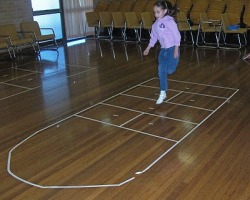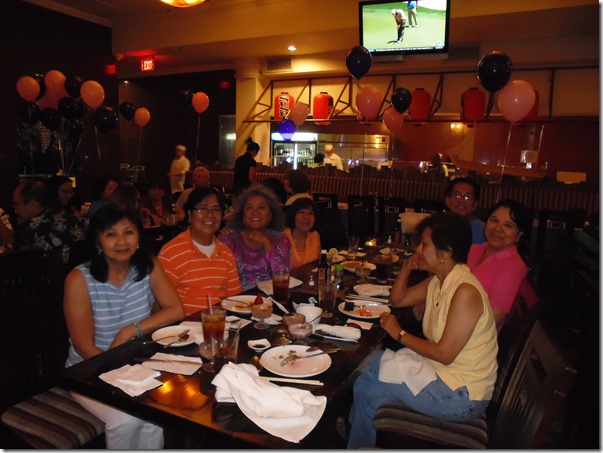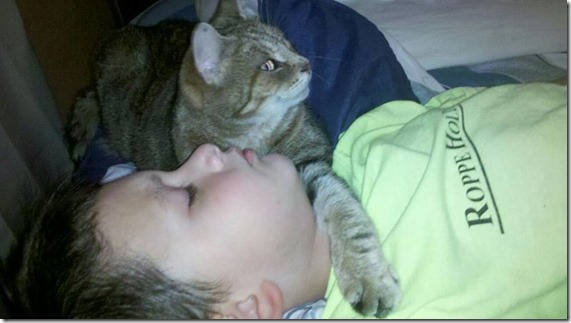By Tetchie Herrera
Growing up in Manila, my siblings and I enjoyed both indoor and outdoor Filipino games, some native to the culture and some variations of Spanish and American games. This was a time when playing games on computers, cellphones, or tablets was unheard of; in fact, there were no electronic devices then. So, the kids of my generation and older had to play with available materials, and we did and had a lot of fun, too!
One traditional Filipino game is luksong-tinik (jump over the thorns). Two “base” players would sit on the ground facing each other and build the base of the “thorns” by alternating one player’s foot over the other’s foot (heel to toes), then one player’s hand over the other’s (see picture below) until they build a high base over which players will jump over without touching the “thorns.” The two players who jump and touch the “thorns” replace the base players, and the game resumes. My brother Mar used to play this with the neighbor boys, as our Mom didn’t want my sister Eve and me to play “boy games.”
Luksong-tinik (Source: skyscrapercity.com)
Another is piko (pronounced with a glottal stop, with accent on last syllable), which is the Filipino version of hopscotch. I used to play this game with my sister Eve. We would first draw the steps to the “moon” with chalk on the cemented pathway in front of our house. Before that was cemented, I remember just getting a twig and just drawing it on the ground under our guava tree in the backyard. (That was before our Dad attached a swing to the tree, then we would take turns on the swing.) Anyway, once that’s done, we looked for suitable cue balls or what we called “pitcha,” to throw on the squares. The one to throw it nearest the moon goes first. One can only use one foot to get from one step to the next, except the moon. When one completes the whole turn, one can choose a “house” marks it with her name and starts again. You can put two feet on your house, but your opponent can’t step on it. If she does, she’s “dead” and forfeits her turn. If you step on a line, you’re also “dead.” The player with the most houses wins the game and can claim the moon as her house.

Piko (Source: larong-pinoy.weebly.com)
A game that I loved playing indoors with my siblings and even my adult relatives is the board game, sungka. I used to think that this game originated from the Chinese, but, according to Wikipilipinas, researchers have traced its origin to Indonesians who might have brought the game to the Philippines when they migrated there. They found traces of the game at an Indonesian stream, known to travelers as the Red River, but was called sonka by early Asians.
Going back to the game, it is played with a sungkaan, a board with 14 hollowed out small holes in the middle and two large holes at both ends (please see picture below). Two players facing each other fill the holes with seven counters each, which could be shells, pebbles or seeds. My family used sigay or shells, which are cheap and available from the market. The object of the game is to put the most counters or shells in your own “house” which is the big hole on your left. The seven holes on your sides are yours and those on the other side are your opponent’s. There are different ways to play the game.
The way we played it was for both players to start dropping one shell each on their respective small holes and own house starting from one of their own holes clockwise towards their opponent’s holes, but not his house. If you end up in a hole with shells in it, you scoop up the shells and continue dropping them one by one around the board. If you end up in an empty hole on your side, you scoop up all the shells on the opposite side and put them all in your house. But if you end up in an empty hole on your opponent’s side, then. you’re “dead” and it’s the other player’s turn. You play alternately until the last shell is gone. Whoever has the most shells in his or her house wins the preliminary game. The game begins again with each putting seven shells in each of their seven holes and the rest in his or her house. The loser of the first game usually does not have enough shells to fill his holes, so he has “burnt houses.” If your opponent carelessly puts shells in your “burnt houses,” you are entitled to them and put them in your own house. If you drop shells in your own burnt houses, your opponent can do the same. Game’s over when all seven holes on one side are empty. Winner is the one with the most shells in his house.
Source: katewashere.com
The game I loved most to play when I was young was patintero or the Filipino version of the American game “tag.” I remember when my Mom had a bonfire under the guava tree in the backyard to rid it of pests, and also to burn the dry leaves from all over the yard. My siblings and I were helping her gather all the dry leaves and twigs, when, suddenly, she had a bright idea. She said, “why don’t we play a game after we put out the fire?” And so, everybody asked, “what game?” And she said, we’ll play “patintero.” As she doused the fire with water and swept them to the side of the back wall, she told us how to play it.
We had to group ourselves into two groups, with five members in each. (Since we were only eight, including the two younger maids, we were only four in each group.) To choose the “it” group, the group leaders play “Jack en Poy” (rock-paper-scissors) while singing the lyrics, which goes:
Jack en Poy, hale-hale-hoy! (Jack and Poy, hale-hale- hoy!) Sinong matalo siyang unggoy! (The loser is a monkey!)
The loser group becomes “it” and lines up on the middle line (see picture), with two at the back. Anybody from the other group who reaches the back fence and cries “save” before someone taps him is saved. But if one member of the group is tapped, the whole group is “it.” What’s fun is we had to sing these lyrics that our Mom taught us before the game starts:
Where’s the fire? Around the building. Is that so? Bicho-bicho!
Then the fun begins. Usually there’s a pikon (bad loser) who cries every time she’s in the “it” group, and it might have been me or my sister. (LOL!) Other than that, we would end up all sweaty and dirty and head for the showers!
There are so many Filipino games in the Philippines, like sipa (game of kick with a washer), palosebo (greased bamboo pole climbing), pitik-bulag (flick with a finger- pretend blind person with hand covering his eyes), and so on. Some are even played during fiestas and made into tournaments with prizes awarded to winners. But these are the ones I remember from my youth. How about you? You have some games that you remember that are played in your own countries?


